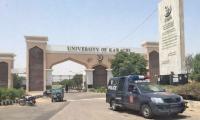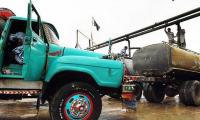Karachi: With visitors thronging the C1 Area graveyard in Liaquatabad on Sunday, the cemetery offered a different view on the eve of this Shab-e-Barat. Rangers recently launched a crackdown on two groups of drug peddlers settled on the graveyard’s two sides, arresting many of their members and forcing others to flee.
The cemetery is located between C1 Area and Mureed Goth. The two ends of the graveyard were held by two rival groups of drug peddlers, one comprising Sindhis and other Baloch. “They [the two groups] fought each other and illegal activities were carried out at the graveyard at night,” Amir Muneer*, a resident of the C1 Area, told The News. He added that the cemetery had almost become a no-go area for outsiders before Rangers conducted several raids during the last six months and rounded up many criminals.
“Rangers blocked the whole area during the raids. It created hurdles for residents, but eventually the area was rid of criminals.” However, Muneer noted that drug peddlers, who were not affiliated with the two groups, were still operating near the graveyard.
Residents also recalled cases of mugging and kidnapping near the cemetery during the last five years because of which people had stopped visiting it. By Sunday evening, many people had gathered at the cemetery and the narrow streets of C1 Area near it were abuzz with the loud horns of motorcycles. Other vehicles were parked at the road between Teen Hatti and Liaquatabad as they were not allowed to enter the streets.
Many visitors complained that some people were charging them parking fee with fake photocopied slips and activists of a religio-political party were supervising the whole process in front of the Liaqauatabd district municipal corporation officials.
“Last week, I had my father’s grave reconstructed as I had stopped coming to the graveyard for the last three years because of the muggings and kidnappings,” said Qasim Bakhsh, a visitor.
However, he was disappointed to see a new grave built on that of his paternal aunt. “My father’s grave was in ruins. Fortunately it was not demolished by grave diggers to bury another body there. But a new grave has been built where my aunt was buried.”
Graveyard ‘mafia’
There is no space available for new graves in the cemetery; therefore old ones are demolished to make new ones, said a grave digger at the cemetery.
Divided into three parts, the graveyard is under the control of three people, who charge money for new graves on the existing ones and protect visitors from muggers and drug peddlers, visitors and the residents of the area told The News.
The first one is a woman, known only as Amma, who claims that she inherited the cemetery from her father, the owner of the farms on the land which was later converted to a graveyard after the Partition.
“I don’t know what my age is,” said Amma, the wrinkles on her face suggesting that she might be well over 70. “We own this land even before the Partition.” She usually sits under a tree on a narrow street between her house and the cemetery during daytime.
After sunset, Amma, mother of three sons and five daughters, goes to Mauripur, where she has another house.
However, Amma only controls one part of cemetery with her sons Mastana and Rashid. Her third son has passed away.
Her nephew, Maqsood, is in possession of the second part, while the third section has been taken over by a man called Haji Sahab alias Wali Bhai, who dresses up in the attire of a non-political religious group.
The three occupants, who have employed subordinates, charge money for graves, starting from a minimum of Rs10,000 to amounts exceeding Rs50,000, depending on the location, space and construction of the grave.
The graveyard ‘mafia’ is also facilitated by the Graveyards Section Municipal Services of the Karachi Metropolitan Corporation, as the department, while issuing an official certificate to register a new grave, leaves three columns empty - “payment given to the gravedigger”, “grave number” and “row/block number”.
“All details are filled in the certificate, but these three columns are deliberately left empty,” a KMC employee told The News on the condition of anonymity.
He added that the officials of the department had fixed their percentage of the share with the graveyard mafia and that was why the column of the “payment given to the gravedigger” was not filled.
The KMC official said the two other columns were left empty because the cemetery had run out of space and new graves were built on old ones and that too without any planning.
“You can’t assign grave numbers or row or block numbers with the system existing there.”
As the cemetery is filled to over capacity, visitors have to walk over graves.
Owais Nizami, a visitor, said he felt uncomfortable walking over graves as his religious teachings forbade him from doing so.
But Shahnawaz, a grave digger who was high on some drug and selling water at the cemetery siphoned from a pipeline using a motor, said they had no other option but to demolish old graves to for new ones.
“It’s a society where so many humans are living without a roof. If we won’t demolish old graves, where will we build new ones? There is no space left in the graveyard,” he added.
This picture taken on January 30, 2023, shows commuters passing through the Empress Market in Pakistan's port city of...
An image of a performance at the ArchiGrooves: Beloved Tracks of Professional Architects’ Student Life, event...
Students and officials seen at the Al-Kawthar University in this representative image.— aku.edu.pk/File KARACHI: Al...
Syed Awais Qadir Shah, speaker of the Provincial Assembly of Sindh receiving a souvenir at the Consulate General of...
A view of an overloaded truck. — APP/FileThe National Highways & Motorway Police , South Zone, convened a meeting...
Sindhi nationalist leader GM Syed.— Facebook@abrarali.mangi.9/File HYDERABAD: The Sindh United Party on Friday...







